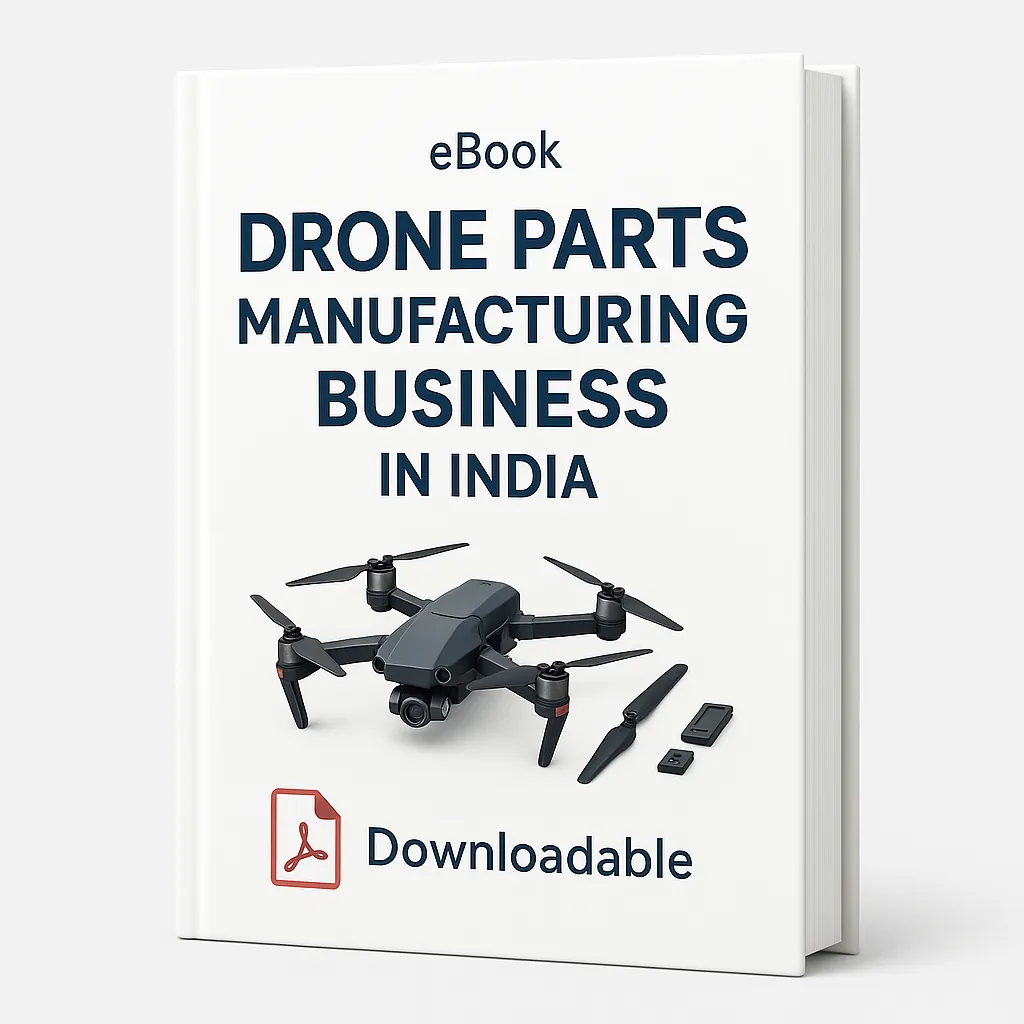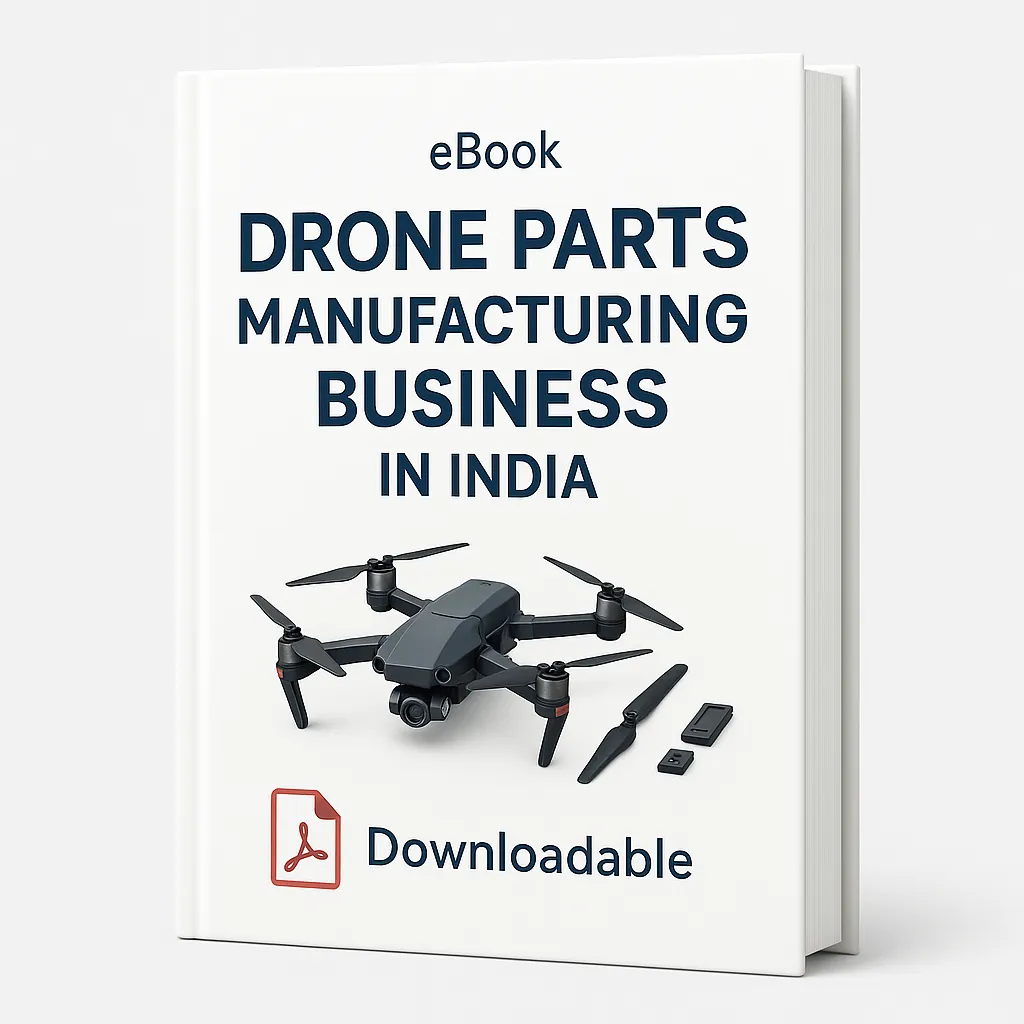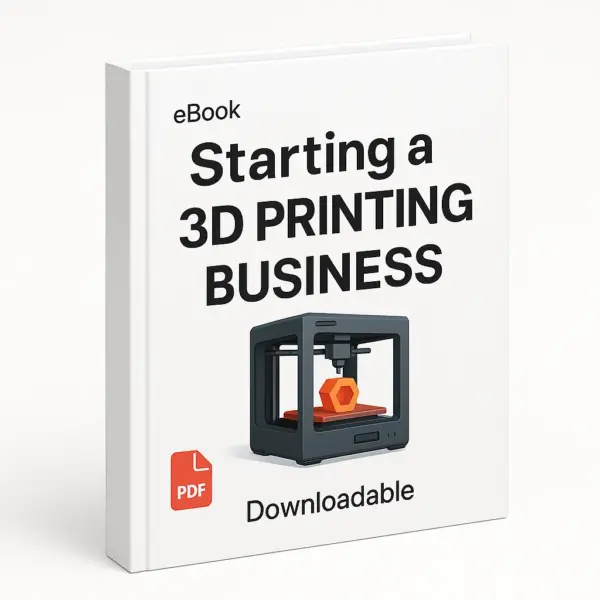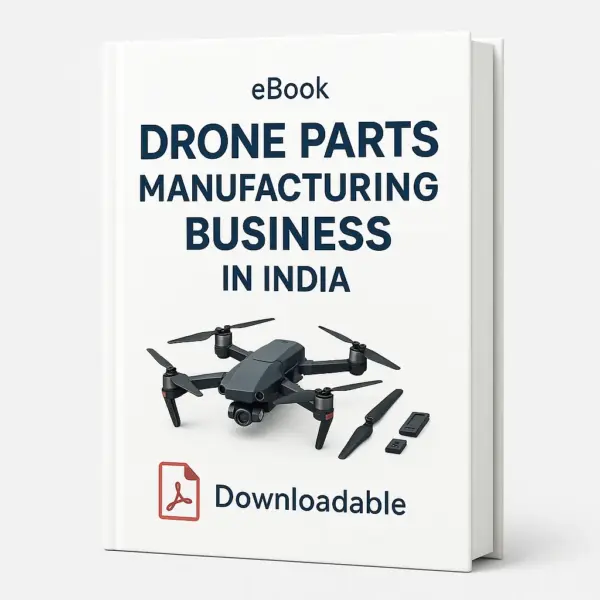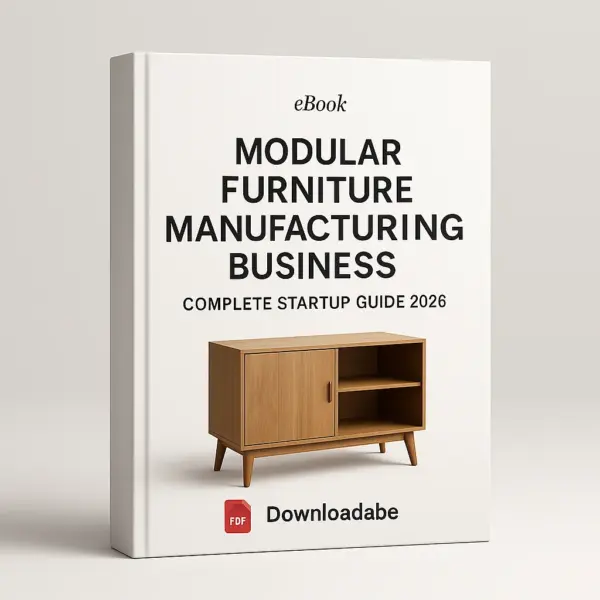Unlock Financial Success with Our eBook
- Complete Business Blueprint
- Indian Market-Focused Insights
- Covers All Drone Components
Table of Contents
Top Strategies for Succeeding in the Drone Parts Manufacturing Business in India
Interested in the drone parts manufacturing business in India? With the market expected to reach ₹1.39 billion by 2030, this article will show you the immense opportunities available. Discover the vital components to make, the machinery you’ll need, and the essential investment details for starting your business.
Key Takeaways
The Indian drone parts manufacturing industry is projected to grow significantly, with opportunities for entrepreneurs to engage in manufacturing essential components amidst challenges like reliance on foreign suppliers.
Investing in advanced machinery such as CNC machines and additive manufacturing technologies is crucial for producing high-quality drone parts that meet industry specifications.
Government incentives, effective marketing strategies, and navigating regulatory requirements are essential for establishing a successful drone parts manufacturing business and expanding export potential.
Understanding the Drone Parts Manufacturing Business in India
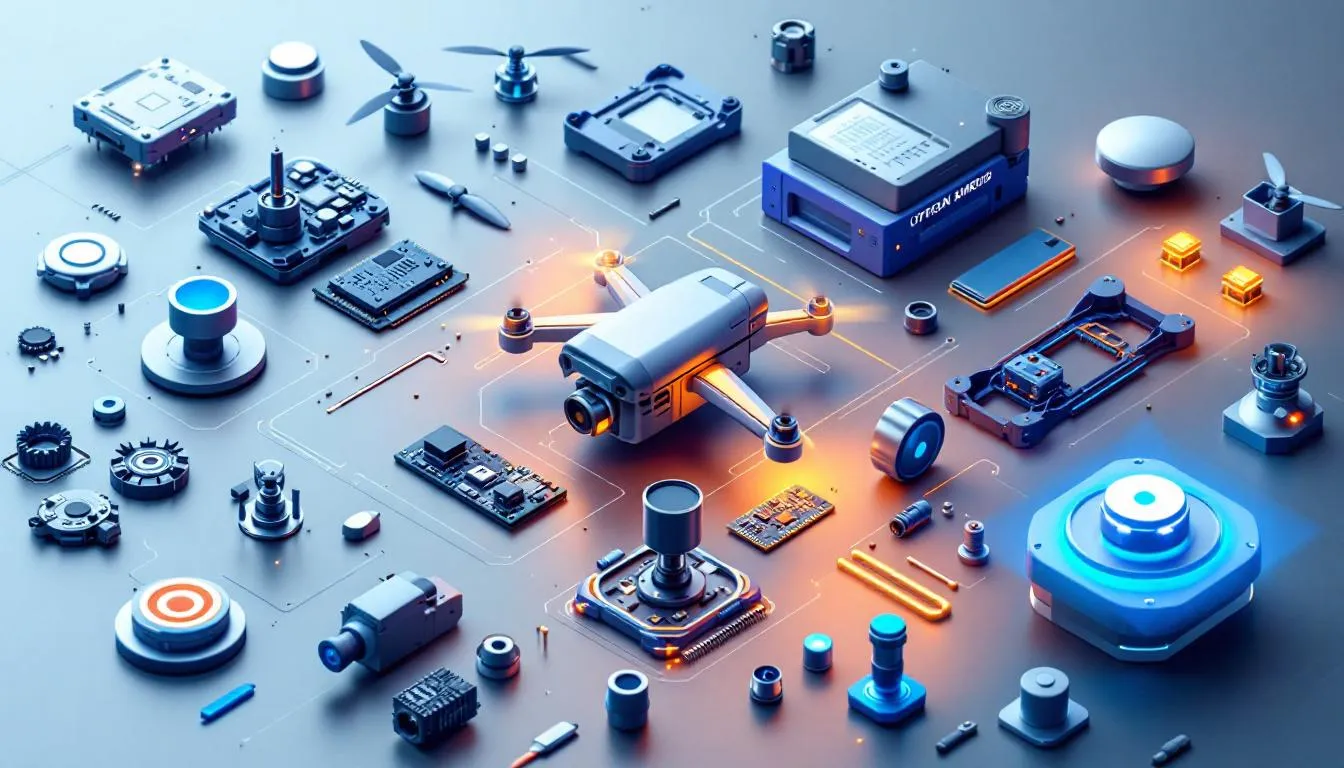
The drone industry in India is on a remarkable growth trajectory, expected to expand from ₹0.47 billion in 2025 to ₹1.39 billion by 2030, marking a compound annual growth rate (CAGR) of 24.4%. This rapid growth is driven by innovations in propulsion, batteries, and autonomy, making drones more efficient, reliable, and capable of performing complex tasks.
However, the drone sector in India faces significant challenges. A high reliance on foreign suppliers for key components and limited payload capacity are barriers that need to be overcome for the industry to reach its full potential. Despite these challenges, the domestic drone manufacturing landscape is evolving within a growing drone ecosystem, with a mix of original equipment manufacturers (OEMs), including garuda aerospace, and an expanding aftermarket.
Understanding the current landscape of the drone industry is crucial for anyone looking to enter this market. The industry’s growth is not just limited to the production of drones but extends to the manufacturing of various drone parts and electronic components, including:
Frames
Motors
Electronic speed controllers
GPS systems Each plays a vital role in the functioning of drones.
Aerial vehicles UAVs are now integral to a wide range of industries, playing key roles in disaster relief, precision agriculture, land surveying, and real-time data collection for environmental monitoring and operational efficiency.
For entrepreneurs, this means there is a broad spectrum of opportunities to explore. Manufacturing high-quality custom drone parts allows you to tap into the growing demand from drone manufacturers and operators, including various drone companies. This demand is further fueled by the increasing use of manufacturing drones and commercial drones—purpose-built for professional tasks in agriculture, construction, and industrial use—in various sectors, including agriculture, logistics, delivery services, surveillance, and drone applications. Additionally, offering drone services can enhance your ability to operate drones and improve your business prospects.
The drone parts manufacturing business in India offers substantial growth potential. Leveraging technological advancements and understanding market needs can position you as a key player in this dynamic booming sector industry trends.
Business Structure and Planning
A solid business structure is the foundation of any successful drone manufacturing company. Defining your company’s mission, vision, and objectives from the outset helps guide decision-making and sets a clear direction for growth. Establishing a robust organizational framework is equally important, as it ensures efficient management of production capacity, supply chain logistics, and quality control processes.
When planning your drone business, it’s essential to conduct a thorough market analysis to identify opportunities and understand industry trends. This includes evaluating the competitive landscape, assessing demand for various drone components, and identifying potential customers in different sectors. Financial projections should be realistic and account for both initial investments and ongoing operational costs, while also outlining strategies for future expansion.
Leveraging government initiatives, such as the Digital Sky platform, can provide valuable opportunities for drone manufacturers to gain market access and streamline regulatory compliance. Staying informed about the regulatory landscape and adapting your business plan accordingly will help you navigate challenges and capitalize on emerging trends. By developing effective marketing strategies and maintaining a flexible, growth-oriented approach, drone companies can position themselves as leaders in the rapidly evolving drone industry.
Essential Drone Components to Manufacture

Diving into the world of drone manufacturing, one must understand the essential drone component and other components that make up a drone. These components are the backbone of any drone, and their quality and performance directly impact the drone’s design, efficiency, and reliability.
The drone frame is a critical component, providing stability and support for all other parts. Typically constructed using materials like aluminum, various plastics, and carbon fiber, the frame ensures the drone’s durability while keeping it lightweight. The role of the drone frame is to provide stability and support for components, making it a fundamental part of the drone’s design.
Key components of a drone’s propulsion and navigation systems include:
Brushless motors: preferred for their efficiency and longevity compared to traditional brushed motors.
Electronic speed controllers (ESCs): manage the power delivered to each motor based on commands from the flight controller. Remote control systems are essential for maneuvering drones and managing flight modes, allowing operators to control drone behavior from a distance.
GPS: allows for enhanced navigation capabilities and features such as return-to-home functions. Advanced sensors and algorithms help drones maintain a stable flight path, especially during complex maneuvers.
Propellers and batteries also play significant roles. The choice of propeller pitch affects the drone’s speed and efficiency, with lower pitches providing smoother flight and higher pitches allowing for increased speed. Balanced propellers minimize vibrations, ensuring a stable flight. Lithium-polymer (LiPo) batteries, designed with a polymer electrolyte, provide greater energy density compared to other battery types, allowing drones to operate efficiently with less weight. Battery technology and the drone’s design directly influence flight time, which is crucial for planning missions and maximizing operational efficiency.
Manufacturing these critical components and understanding the production processes can establish your business as a reliable supplier in the supply chain of the drone industry. Understanding the intricacies of each part and ensuring high-quality production will help you meet the demands of drone manufacturers and operators.
Required Machinery and Equipment
Investing in the right machinery and equipment is crucial for manufacturing high-quality drone parts. Precision and efficiency in the manufacturing process are crucial to produce components that meet the stringent requirements of drone manufacturers.
CNC (Computer Numerical Control) machines are critical for producing drone parts with precise dimensions and high repeatability. These machines are capable of cutting and shaping materials with extreme accuracy, ensuring that each component meets the required specifications. Injection molding is another important manufacturing processes, widely used for mass-producing plastic components like propeller guards and battery casings.
Milling machines are also extensively used to cut and shape materials into parts that meet the intricate specifications required for drones. Additionally, additive manufacturing, or 3D printing, enables the creation of complex drone parts quickly and at lower costs for prototyping. This technology allows for rapid iteration and testing of new designs, which is vital in an industry where innovation is key. Additive manufacturing is especially valuable for producing highly customized components tailored to the most demanding projects, meeting rigorous requirements and enabling innovative solutions for the drone industry.
Composite fabrication techniques, such as hand lay-up, are essential for crafting lightweight drone structures from materials like carbon fiber. These techniques ensure that the drone frames are strong yet lightweight, which is crucial for optimal performance.
Equipping your manufacturing unit with advanced machines and technologies enables efficient high-quality drone part production. This investment in cutting-edge technology, drone technology, UAV technology, and technological capabilities will set your business apart in the competitive drone industry.
Raw Materials Needed for Drone Manufacturing

The choice of raw materials significantly impacts the performance and durability of drone components. Understanding the properties of these materials and their applications in drone manufacturing is essential for producing high-quality parts.
Carbon fiber is the primary material used for drone frames due to its strength and lightweight properties. This material provides the necessary durability without adding excessive weight, which is crucial for maintaining flight efficiency. Plastic polymers are also commonly used in various drone components due to their versatile physical properties and lightweight nature.
Lithium-polymer (LiPo) batteries are the standard power source for drones, providing high current output essential for flight operations. These batteries have a greater energy density compared to other battery types, allowing drones to operate efficiently with less weight. Key raw materials required for drone manufacturing include carbon fiber, plastic polymers, and lithium battery cells.
Sourcing high-quality raw materials and understanding their properties ensures your drone parts meet industry performance standards with minimal waste. This focus on quality control will help you build a reputation as a reliable supplier in the drone manufacturing ecosystem.
Quality Control and Assurance
Quality control is a cornerstone of successful drone manufacturing, ensuring that every drone and component meets the highest standards of safety, reliability, and performance. Drone manufacturers must implement rigorous quality control processes at every stage of production, from sourcing raw materials like carbon fiber and sheet metal to the final inspection of finished drones.
This involves comprehensive testing and inspection protocols for all drone components, including motors, flight controllers, and protective elements. Adhering to safety standards and regulatory requirements set by authorities such as the Directorate General of Civil Aviation is essential for legal compliance and market acceptance. Regular audits and assessments help identify areas for improvement, ensuring that quality control measures remain effective and up-to-date.
By prioritizing quality assurance, drone manufacturers can build a reputation for excellence, foster customer trust, and reduce the risk of costly recalls or failures. Consistently delivering high-quality drones not only meets the expectations of clients but also strengthens your position in the competitive drone industry.
Investment Analysis and Profitability
Starting a drone parts manufacturing business requires a substantial investment, but the potential for profitability is significant. A strong financial plan is necessary to detail expected costs and income, aiding in investment decisions. This plan should include initial setup costs, operational expenses, and projected revenues.
Effective planning can ensure managerial resilience against financial risks, allowing you to adjust financial projections as the business matures to maintain sustainable growth and future growth and profitability. Demonstrating market opportunities to investors enhances the chances of securing funding, and building good relationships with investors is crucial in increasing funding certainty.
Creating a well-defined business plan is fundamental for attracting venture capitalists. A comprehensive financial strategy helps in informed decision-making and securing investments. For a small unit, the required investment is around ₹10–₹20 lakh, with a monthly profit potential of ₹1–₹2 lakh, presenting profitable prospects. The expected ROI period for a drone manufacturing business is approximately 18 months.
A well-structured financial plan, coupled with understanding market opportunities and investor relationships, sets your venture capital business on a path to profitability and growth.
Navigating Licenses and Registrations
Operating a drone manufacturing business in India requires navigating a complex array of regulatory requirements. Compliance with these regulations ensures that your products meet safety and operational standards, which is crucial for entering the market.
Drones are controlled remotely by operators, which necessitates strict oversight to ensure safe and responsible operation. Drones must comply with a type certificate to ensure they meet safety and operational standards before they can be flown. The Directorate General of Civil Aviation (DGCA) issues type certificates based on a review of the drone’s design and compliance with relevant standards. The process for obtaining a type certificate includes submitting prototype details and undergoing tests by authorized entities.
Remote pilot licenses are issued after completing drone pilot training with authorized organizations, and they are valid for ten years. Nano and micro unmanned aerial vehicles do not require type certification or a remote pilot license for non-commercial usage. An unmanned aerial vehicle does not fall under these requirements.
The process of drone registration involves creating a profile on the Digital Sky platform and submitting necessary documentation. A unique identification number (UIN) is mandatory for operating drones and must be obtained through the Digital Sky platform. Licenses and registrations needed for drone manufacturing include MSME registration, GST registration, and DGCA approval.
Understanding and complying with this regulatory landscape and the requirements of regulatory bodies ensures your drone parts manufacturing business operates legally and efficiently within drone laws while adhering to safety standards.
Government Schemes and Support
The Indian government offers various schemes and support systems to promote local drone manufacturing. These initiatives provide financial incentives and subsidies, making it easier for businesses to thrive in the drone industry.
The schemes related to drones include:
The Production Linked Incentive (PLI) Scheme, which promotes local drone manufacturing by offering financial incentives based on annual sales.
The Kisan Drone Yojana, which provides subsidies to encourage the use of drones in agriculture, benefiting small and marginal farmers.
The Drone Shakti Scheme, which supports drone startups and encourages the establishment of Drone-as-a-Service models.
Over 23 companies have been approved under the PLI Scheme, reinforcing India’s drone manufacturing ecosystem. Policy incentives from both central and state governments can stimulate domestic demand for drones, enabling manufacturers to scale up operations and target international markets. These government schemes and support systems play a crucial role in nurturing the growth of the drone manufacturing sector in India.
These government initiatives can significantly boost your business, helping you scale operations and compete globally.
Training and Skill Development
The rapid advancement of drone technology has created a strong demand for specialized skills within the drone industry. For drone manufacturers, investing in comprehensive training and skill development programs is vital to maintaining a competitive edge. This includes providing employees with access to workshops and courses on drone pilot training, flight controller systems, and the assembly and maintenance of critical components.
Collaborating with research institutes and universities can offer valuable opportunities to stay abreast of cutting edge technology and industry best practices. These partnerships can also facilitate knowledge transfer and foster innovation within your organization. Training should not only cover technical skills but also emphasize safety procedures, regulatory compliance, and responsible drone operations.
By equipping your workforce with the latest knowledge and expertise, you can enhance productivity, drive innovation, and ensure that your team is prepared to tackle the challenges of modern drone manufacturing. A skilled workforce is essential for delivering high-quality drones and maintaining a strong reputation in the market.
Marketing and Sales Strategies
Effective marketing is essential for connecting with potential clients and building a strong brand in the drone industry. Utilizing online platforms, social media, and participating in industry events are key promotional methods for a drone business. Content marketing and the use of social media are effective online marketing strategies that can significantly enhance visibility.
Expanding services and offerings enhances market reach and competitiveness. A successful marketing strategy includes supplying to drone assemblers and utilizing B2B portals to sell parts.
In addition to online marketing, traditional methods such as attending trade shows and networking with industry professionals can also be beneficial. By combining these strategies, you can effectively promote your products and reach a broader audience.
Implementing a comprehensive marketing and sales strategy will help you establish a strong presence in the drone industry, attracting customers and driving sales.
Applications and Uses
Drones have revolutionized a multitude of industries, offering innovative solutions for tasks ranging from aerial photography and surveying to package delivery and agricultural monitoring. Drone manufacturers should explore the diverse applications of drone technology across various sectors, including construction, infrastructure inspection, environmental monitoring, and public safety.
Understanding the unique needs of each industry allows drone companies to design and manufacture customized drones equipped with specialized components such as high-resolution cameras, advanced sensors, and robust communication systems. By tailoring products to specific applications, manufacturers can address industry-specific challenges and unlock new business opportunities.
The growing adoption of drones in different sectors not only drives demand for advanced drone components but also fuels ongoing innovation. As more industries recognize the value of drone technology, the potential for growth and diversification within the drone business continues to expand.
The Drone Ecosystem
The drone ecosystem is a dynamic network that brings together drone manufacturers, operators, service providers, regulatory bodies, and other key stakeholders. This interconnected environment is supported by a wide array of drone components, software solutions, and services that collectively enable the safe and efficient operation of drones.
For drone manufacturers, understanding and engaging with the broader drone ecosystem is crucial. This means considering the needs of drone operators, pilots, and maintenance teams when developing new products and services. Collaboration with other stakeholders, including research institutions and regulatory bodies, can drive industry-wide innovation and help shape the future of drone technology.
Government policies, regulatory frameworks, and evolving industry trends all play a significant role in influencing the adoption and use of drones across various sectors. By staying informed and actively participating in the drone ecosystem, manufacturers can navigate the complexities of the drone industry, anticipate changes, and seize emerging opportunities for growth and development.
Export Potential of Indian-Made Drone Parts

The export potential of Indian-made drone parts is substantial, with growing demand in various sectors globally. Indian manufacturers have the opportunity to export drone parts like motors and electronics to markets such as the USA and Japan.
Key strategies to enhance India’s ability to export drone components include:
Simplified procurement processes
Government support for local manufacturing
Establishing operational drone testing sites to boost manufacturing capabilities and export readiness of Indian drone parts.
Export potential includes the ability to export drone motors, frames, and electronics to countries like the USA and Japan. Focusing on quality and meeting international standards allows Indian manufacturers to tap into lucrative markets, driving growth and profitability.
Overcoming Challenges and Risk Factors
The drone manufacturing sector in India faces several challenges, including:
High research and development costs, which present a barrier to innovation as funding is largely directed towards consumer technology rather than deep-tech sectors.
Cybersecurity threats, especially for drones utilizing common off-the-shelf components that may be vulnerable to hacking.
Competition from China.
Adoption of agricultural drones in rural India is limited due to high costs and farmers’ lack of awareness about their benefits. Additionally, India faces challenges in developing effective, affordable counter-drone technologies as drone misuse increases. Integrating artificial intelligence into drone systems can help automate monitoring, optimize operations, and improve decision-making in agriculture and livestock management, making drones more efficient and valuable for farmers.
Competition from China poses a significant challenge, as they have established supply chains and lower production costs for drone parts. Addressing these challenges requires a strategic approach, including investing in R&D, enhancing cybersecurity measures, and raising awareness about the benefits of drones. By overcoming these obstacles, you can ensure the long-term success of your drone parts manufacturing business.
Download the Drone Parts & Components Manufacturing Business eBook
For those looking to delve deeper into the intricacies of the drone parts manufacturing business, our comprehensive eBook is an invaluable resource. This eBook provides detailed insights into:
Setting up a profitable drone parts manufacturing business
A step-by-step business setup guide
Machinery and supplier details
And much more.
By downloading this eBook, you will gain access to expert knowledge and practical advice, helping you navigate the complexities of the drone industry with confidence. Don’t miss this opportunity to equip yourself with the information you need to succeed in the booming drone sector through drone training.
Download now and take the first step towards building a successful drone parts manufacturing business.
Summary
The drone parts manufacturing business in India presents an exciting and lucrative opportunity for entrepreneurs. With the industry projected to grow significantly over the next few years, there is ample potential for growth and profitability. By focusing on key components, investing in the right machinery, and sourcing high-quality raw materials, you can position your business as a reliable supplier in the drone ecosystem.
Navigating the regulatory landscape and leveraging government schemes and support are crucial for ensuring compliance and accessing financial incentives. Effective marketing and sales strategies, combined with a strong understanding of export potential, will help you reach a broader audience and tap into international markets.
In conclusion, the drone industry in India is poised for transformative growth, and by following the strategies outlined in this guide, you can capitalize on this opportunity. Training and certifying drone pilots is essential to support industry expansion and meet the growing demand across sectors. It is also important to operate drones safely by adhering to regulations and best practices. Regular drone maintenance is vital to ensure optimal performance and safety. Embrace the future of drone technology and make your mark in this dynamic and innovative sector.
Frequently Asked Questions
What is the initial investment required for a drone parts manufacturing business in India?
The initial investment for a drone parts manufacturing business in India typically ranges from ₹10 to ₹20 lakh. This can lead to a promising monthly profit of ₹1 to ₹2 lakh, with a return on investment expected within about 18 months.
What are the essential components needed for drone manufacturing?
For successful drone manufacturing, you need key components such as drone frames, brushless motors, electronic speed controllers (ESCs), GPS systems, propellers, and lithium-polymer (LiPo) batteries. These elements are crucial for ensuring optimal performance and functionality.
What licenses and registrations are required to start a drone parts manufacturing business in India?
To start a drone parts manufacturing business in India, you will need MSME registration, GST registration, DGCA approval, type certificates, and remote pilot licenses. Ensuring compliance with these requirements is crucial for successful operations.
How can I market my drone parts manufacturing business effectively?
To market your drone parts manufacturing business effectively, focus on online platforms, engage in social media, create valuable content, participate in industry events, and establish partnerships with drone assemblers and B2B portals. These strategies will enhance your visibility and connect you with your target audience.
What government schemes and support are available for drone manufacturers in India?
Drone manufacturers in India can benefit from schemes like the Production Linked Incentive (PLI) Scheme, Kisan Drone Yojana, and Drone Shakti Scheme, all designed to offer financial support and incentives for local manufacturing. These initiatives are key in fostering growth in the drone industry.
Start Your Drone Manufacturing Journey
- Comprehensive guide to drone parts manufacturing
- Key strategies for business success
- Expert insights into the Indian market
- Limited-time offer available
Unlock the Drone Parts Market with Expert Guidance
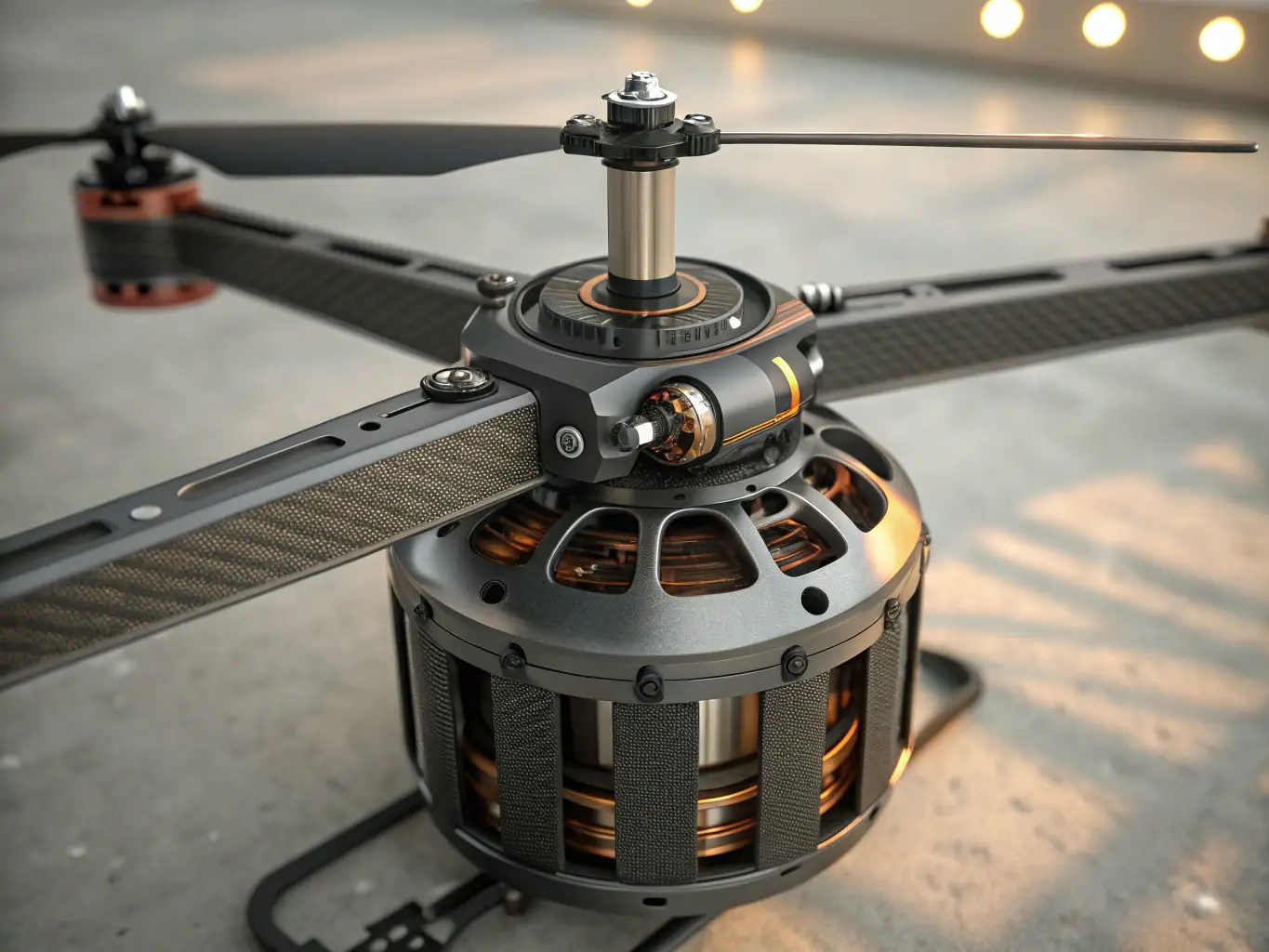
Understand the Market Dynamics
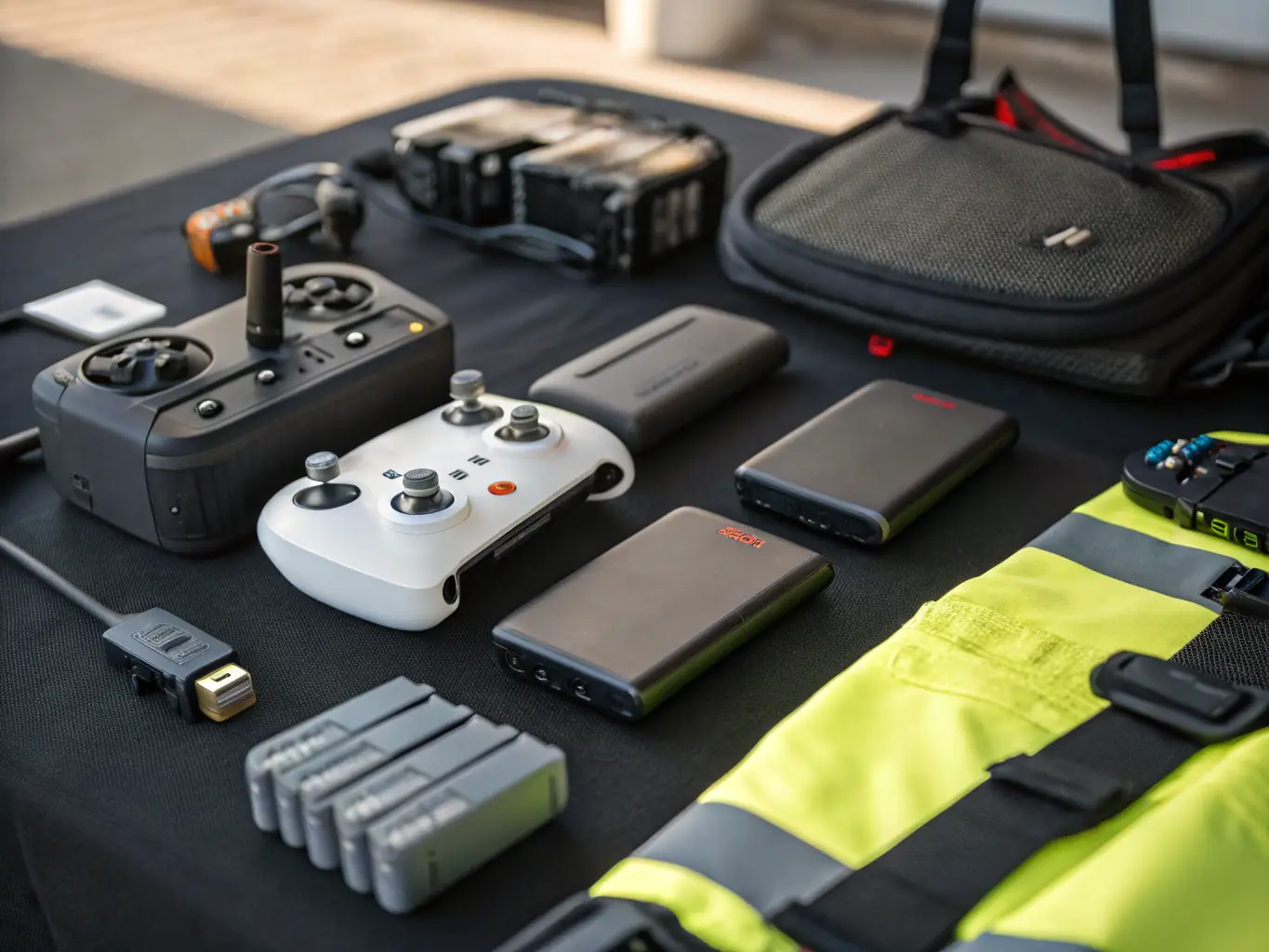
Navigate Complex Regulations

Optimize Manufacturing Processes
Start Your Drone Manufacturing Journey Today
- Comprehensive guide to drone parts manufacturing
- Step-by-step business plan included
- Expert insights from industry leaders
- Secure your future in a booming market
-

eBook AI Manufacturing Ideas
₹500 -

eBook White Label Business
₹500 -

eBook Indian Jewellery Business
₹500 -

eBook Imitation Jewellery Business
₹500 -

eBook Diamond Gemstone Jewellery
₹500 -

eBook Jewellery Franchise
₹500 -

eBook Jewellery Export
₹500 -

eBook Lab Grown Diamond
₹500 -

eBook Medical Devices Manufacturing
₹500 -

eBook Ayurvedic Cosmetic
₹500 -

eBook 3D Printing Business
₹500 -

eBook Rare Earth Magnet Recycling
₹500 -

eBook Gold Refining Business
₹500 -

eBook Drone Parts Manufacturing
₹500 -

eBook Moduler Funiture
₹500 -

eBook on Future of Agribusiness
₹500
